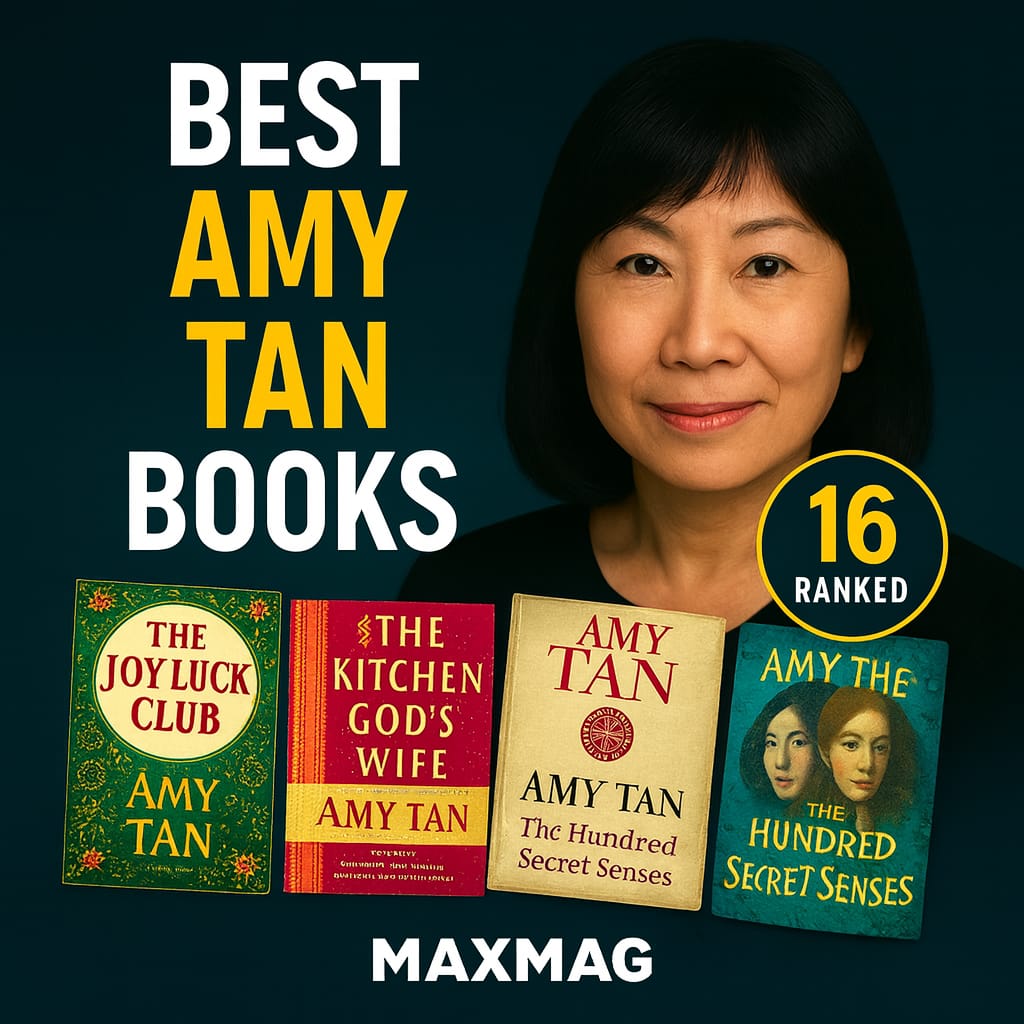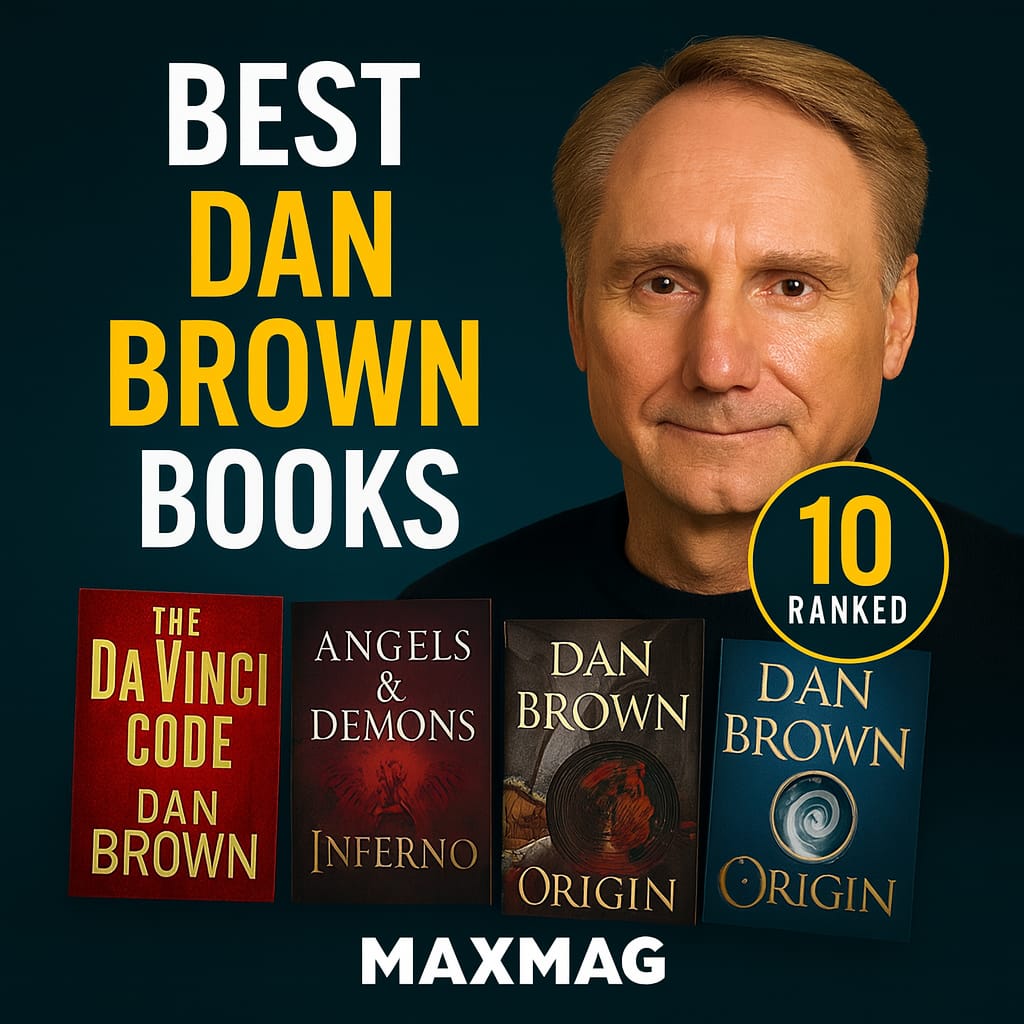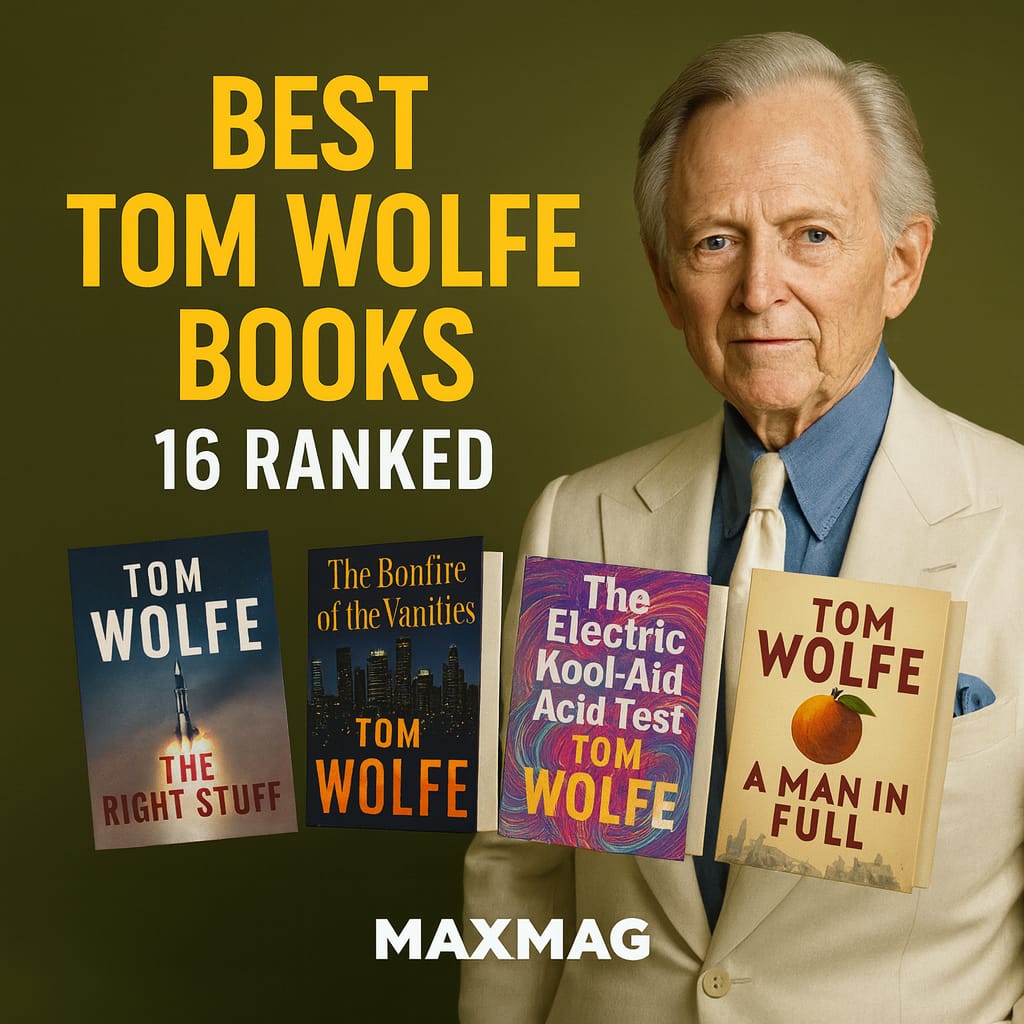
Thomas Kennerly Wolfe Jr. from Richmond, Virginia made Best Tom Wolfe Books synonymous with counterculture reportage and big‑city sagas. He worked across nonfiction collections, criticism, and later panoramic novels. He is commonly associated with “New Journalism,” stitching scenes, dialogue, and status detail into reported narratives. Famous titles include The Electric Kool‑Aid Acid Test and The Right Stuff. His fiction landmarks include The Bonfire of the Vanities, A Man in Full, and I Am Charlotte Simmons. Wolfe’s career stretches from 1960s magazine writing to books that continued well into the 2000s and 2010s. For a concise official biography, see the U.S. National Endowment for the Humanities’ Jefferson Lecture page on Wolfe (NEH profile).
Wolfe’s breakout came with The Electric Kool‑Aid Acid Test, while his broadest popular reach includes The Right Stuff and the Wall Street epic Bonfire. Motifs recur: status, class, aspiration, spectacle, institutional theater, and the music of spoken language. Readers still care because the reporting and the novels track eras when American identities were renegotiated in public. This ranked guide gathers 16 titles across nonfiction, essays, and novels. It is “a ratings‑led climb from deep cuts to consensus classics.” To keep the scope sharp, only stand‑alone books are counted; anthologies by other editors are excluded. The phrase Best Tom Wolfe Books here means books written or edited by Wolfe that have wide, verifiable reader ratings.
16 Best Tom Wolfe Books in a Rising Rating Order
Methodology & Updates
Primary sources: Goodreads title pages captured on October 19, 2025; ties resolved by year, then A–Z title. This ratings‑led guide to Best Tom Wolfe Books uses the latest available community averages to order the works. Positions within the Best Tom Wolfe Books list may shift as new ratings accrue or editions consolidate; the framework keeps Best Tom Wolfe Books transparent about how movements happen.
#1) Back to Blood – 2012
- Author: Tom Wolfe
- Published: 2012
- Work Type / Genre Tags: novel, social novel, city mosaic
- Themes: immigration, ethnicity, status, media, policing
- Goodreads Rating: 3.31/5
Miami forms the setting as Cuban‑American police officer Nestor Camacho and medical assistant Magdalena navigate a city of overlapping communities. A dramatic bayfront arrest propels Nestor into a media glare that threatens his standing at work and at home. He seeks to stabilize his job and relationship while a hungry newsroom hunts for spectacle. Their paths intersect with museum patrons, political operatives, and activists whose interests collide. Mid‑story, an art‑world controversy and rival cops’ investigations complicate loyalties. The stakes rise as leaks, talk‑radio narratives, and protests entangle careers and reputations. The climax advances toward a public reckoning that forces choices in front of cameras. The endpoint leaves characters positioned for new beginnings while signaling the city’s restless churn.
#2) Hooking Up – 2000
- Author: Tom Wolfe
- Published: 2000
- Work Type / Genre Tags: essays, reportage, novella
- Themes: technology, sex, status, media, late‑1990s culture
- Goodreads Rating: 3.34/5
Essays move from Silicon Valley briefings and wired households to East‑Coast salons and editorial offices. An opening piece maps dating codes and celebrity rituals at the edge of the dial‑up era. The immediate aim is to track how money, manners, and bandwidth reshape courtship and ambition. Executives, critics, and socialites recur as sketches that show careers rising and falling online. Mid‑book, a newsroom novella follows a television sting as producers, soldiers, and handlers trade leverage. The complications build through broadcast deadlines, anonymous tips, and rival agendas. The closing pages circle back to the question of what connectivity does to private life. The collection ends by fixing its characters in a media ecosystem they helped create.
#3) I Am Charlotte Simmons – 2004
- Author: Tom Wolfe
- Published: 2004
- Work Type / Genre Tags: novel, campus novel, coming‑of‑age
- Themes: class, sex, athletics, language, identity
- Goodreads Rating: 3.46/5
A first‑year student from a North Carolina town arrives at the elite, fictional Dupont University. She meets a star basketball forward, a fraternity insider, and a driven science student whose goals compete. Her immediate objective is to keep her scholarship and protect her sense of self. Dorm rituals, practices, and parties introduce codes that challenge her beliefs. Mid‑semester crises around injuries, grades, and rumors force public decisions. The pressure escalates as secrets move from chat rooms to headlines. The arc bends toward a campus‑wide moment that tests friendships and future plans. The final pages leave her charting a path between ambition and belonging.
#4) The Kingdom of Speech – 2016
- Author: Tom Wolfe
- Published: 2016
- Work Type / Genre Tags: nonfiction, intellectual history, polemic
- Themes: language, evolution debates, ideas, authority
- Goodreads Rating: 3.56/5
The narrative opens amid Victorian science and the early framing of evolution. It introduces Charles Darwin’s circle and later linguistic theories that attempt to explain speech. The near‑term goal is to trace claims over who accounts for language’s origins. Researchers, rival schools, and field expeditions appear in case studies that anchor disputes. Midway, correspondence and lectures show how hypotheses spread through institutions. The stakes rise as competing models reach classrooms and public forums. The trajectory points toward a showdown over which theory commands the narrative. The book closes by underscoring how speech itself drives human coordination and status.
#5) The Pump House Gang – 1968
- Author: Tom Wolfe
- Published: 1968
- Work Type / Genre Tags: essays, reportage, subculture portraits
- Themes: youth scenes, status, transatlantic style, leisure
- Goodreads Rating: 3.58/5
Linked dispatches move from a La Jolla beach hangout to London flats and continental clubs. Early chapters sketch surfers, designers, and tastemakers who draft new social codes. The immediate objective is to show how small groups set broader manners and speech. Photographers, shop owners, and party hosts reveal networks behind the display. Mid‑book, transoceanic trips tie scenes together as magazines amplify the look. Attention from press and rivals tests friendships as cliques drift and re‑form. The momentum steers toward a moment when a scene’s leaders confront copies of themselves. The collection lands with its characters caught between lasting influence and the next wave.
#6) Mauve Gloves & Madmen, Clutter & Vine – 1976
- Author: Tom Wolfe
- Published: 1976
- Work Type / Genre Tags: essays, sketches, short fiction
- Themes: the “Me Decade,” war recollections, metropolitan rituals
- Goodreads Rating: 3.60/5
Vignettes cluster around apartments, offices, parties, and airfields in the long aftermath of the 1960s. A recurring narrator visits veterans, celebrities, and commuters who revise their daily choreography. The aim is to observe how people arrange rooms, schedules, and stories to project success. Editors, publishers, and friends map hidden ladders that govern introductions and favors. Midway, an aviation sketch and a gallery visit widen the canvas to public arenas. Complications arrive when gossip, envy, and invitation lists drive decisions more than principle. The book heads toward moments when characters realize they are performing for one another. It ends with the uneasy balance between private memory and public display.
#7) The Kandy‑Kolored Tangerine‑Flake Streamline Baby – 1965
- Author: Tom Wolfe
- Published: 1965
- Work Type / Genre Tags: essays, New Journalism, pop culture
- Themes: customization, celebrity, speech patterns, spectacle
- Goodreads Rating: 3.75/5
Travel pieces carry the reader into custom‑car garages, recording studios, and press lines. An early dispatch watches detailers, promoters, and fans build scenes around chrome and sound. The near‑term goal is to show how talk and surfaces create a marketplace for attention. Label executives, DJs, and fixers establish rhythms that turn fads into careers. Midway, West‑Coast miles connect to New York parties where styles change hands. Complications follow when rivalries pit impresarios and artists over image and credit. The sequence drives toward a collision between hype and craft. The book closes on characters still chasing the next debut.
Early Currents to Core Classics — Best Tom Wolfe Books
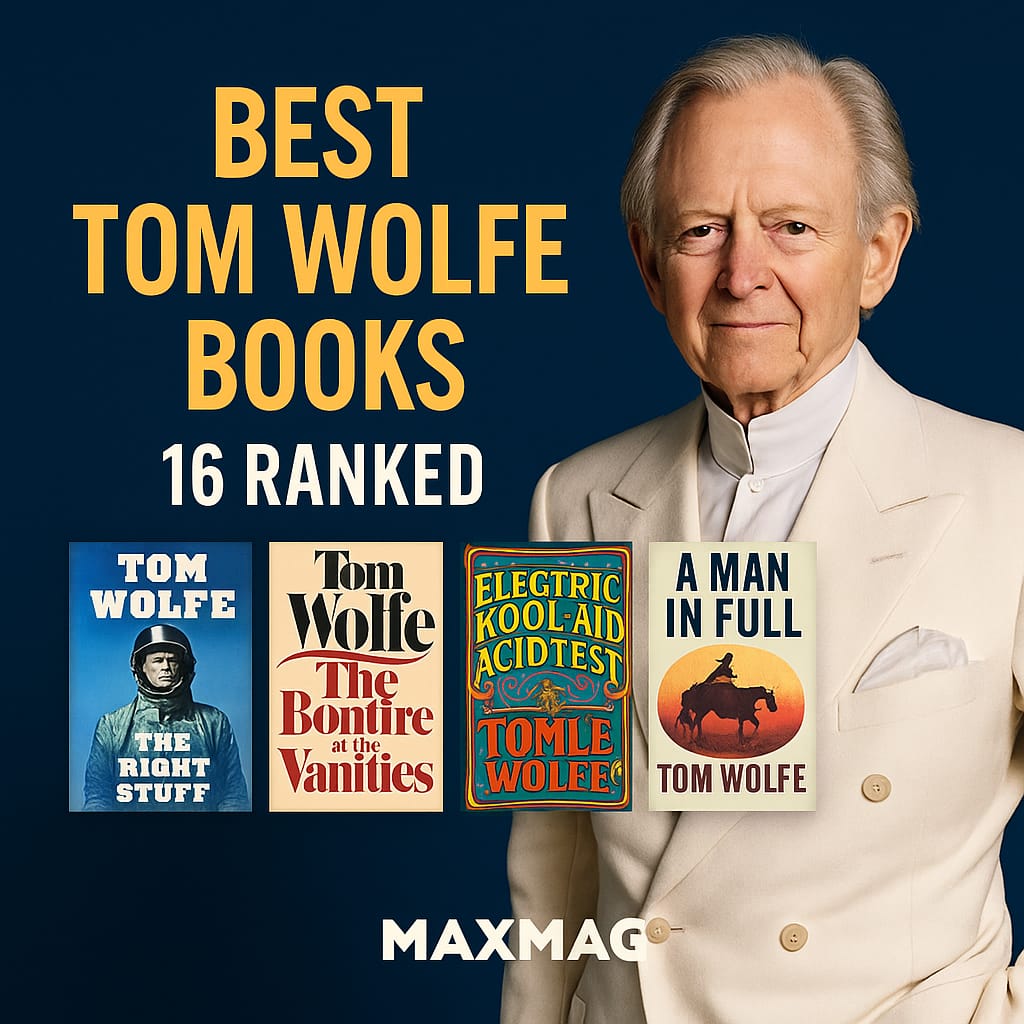
#8) From Bauhaus to Our House – 1981
- Author: Tom Wolfe
- Published: 1981
- Work Type / Genre Tags: nonfiction, architecture critique, cultural history
- Themes: modernism, elites, taste, cities
- Goodreads Rating: 3.77/5
The narrative begins with European design schools and the migration of ideas to the United States. Architects, patrons, and critics appear as characters in a long conversation about buildings. The immediate goal is to trace how manifestos became office towers, housing blocks, and campuses. Relationships among museums, universities, and firms show how reputations are made. Mid‑book case studies follow specific skylines as a style gains institutional force. Resistance and fashion cycles complicate projects and commissions. The arc points to a summing‑up of how orthodoxy and taste travel together. The final pages leave a city map marked by arguments in steel and glass.
#9) Radical Chic & Mau‑Mauing the Flak Catchers – 1970
- Author: Tom Wolfe
- Published: 1970
- Work Type / Genre Tags: long‑form essays, reportage
- Themes: philanthropy, protest, image, institutions
- Goodreads Rating: 3.82/5
The first piece enters a Manhattan fundraiser where guests and activists share a salon. A conflict appears between fashionable performance and the demands of street politics. The immediate aim is to follow how hosts, organizers, and officials negotiate terms. Caterers, security, and publicists become part of the choreography behind the evening. In the companion piece, a government office faces blunt confrontations over services and power. New alliances and tactics raise pressure as meetings multiply. The structure moves toward a final scene that exposes what each side can and cannot yield. The ending fixes the players within an ongoing theater of advocacy.
#10) The Purple Decades: 1960–1980 – 1982
- Author: Tom Wolfe
- Published: 1982
- Work Type / Genre Tags: selected journalism, cultural anthology
- Themes: celebrity, politics, design, taste
- Goodreads Rating: 3.83/5
Selections from two turbulent decades gather into one reader. Early entries revisit car culture, studio lots, and editorial offices where trends were named. The organizing goal is to show episodes that link style, money, and social change. Editors, moguls, and artists appear in cross‑cut scenes that track attention. Mid‑volume transitions carry the chronology forward through urban booms and media shocks. Cross‑references deepen as personalities echo across pieces. The progression leans toward a summing‑up that connects early dispatches to later essays. The last pages leave a panoramic snapshot of a culture in motion.
Later‑Middle Turns — Best Tom Wolfe Books
#11) The Painted Word – 1975
- Author: Tom Wolfe
- Published: 1975
- Work Type / Genre Tags: nonfiction, art criticism, cultural history
- Themes: theory, markets, museums, critics
- Goodreads Rating: 3.85/5
The book opens in galleries where manifestos and canvases compete for authority. Founders of mid‑century movements enter as named figures in a debate. The immediate purpose is to chart how theory steps in front of paint. Dealers, collectors, and curators build alliances that decide which names ascend. Case studies of exhibitions and reviews show how arguments travel from journals to prices. Tensions rise as rival schools challenge one another. The line moves toward a concluding scene that juxtaposes rhetoric with objects on the wall. The close returns to the question of who really sets taste.
#12) A Man in Full – 1998
- Author: Tom Wolfe
- Published: 1998
- Work Type / Genre Tags: novel, social novel, urban drama
- Themes: debt, pride, business, law, sport
- Goodreads Rating: 3.89/5
Atlanta provides the stage as developer Charlie Croker faces creditors, rivals, and a shrinking empire. A warehouse worker and a rising lawyer enter intertwined storylines with their own troubles. The immediate objective for each man is survival with dignity as court dates and deadlines close in. Bankers, politicians, and team owners set terms in backrooms and boardrooms. Mid‑novel twists connect personal crises to city projects and football stakes. New evidence and alliances shift leverage from scene to scene. The narrative aims toward a showdown that forces reckonings at home and in public. The final chapters leave reputations remade and futures uncertain.
#13) The Electric Kool‑Aid Acid Test – 1968
- Author: Tom Wolfe
- Published: 1968
- Work Type / Genre Tags: nonfiction, reportage, road chronicle
- Themes: counterculture, community, performance, law
- Goodreads Rating: 3.92/5
A West‑Coast circle forms around novelist Ken Kesey and a painted bus. Early chapters follow trips through California towns and psychedelic gatherings. The immediate aim is to witness a group inventing its own customs and rites. Musicians, sheriffs, and neighbors appear as encounters test boundaries. Mid‑journey episodes track arrests, cross‑country rides, and an expanding legend. Media attention and internal strains reshape loyalties as the circle grows. The arc moves toward a threshold where the experiment meets consequences. The book closes on altered trajectories for the people who rode along.
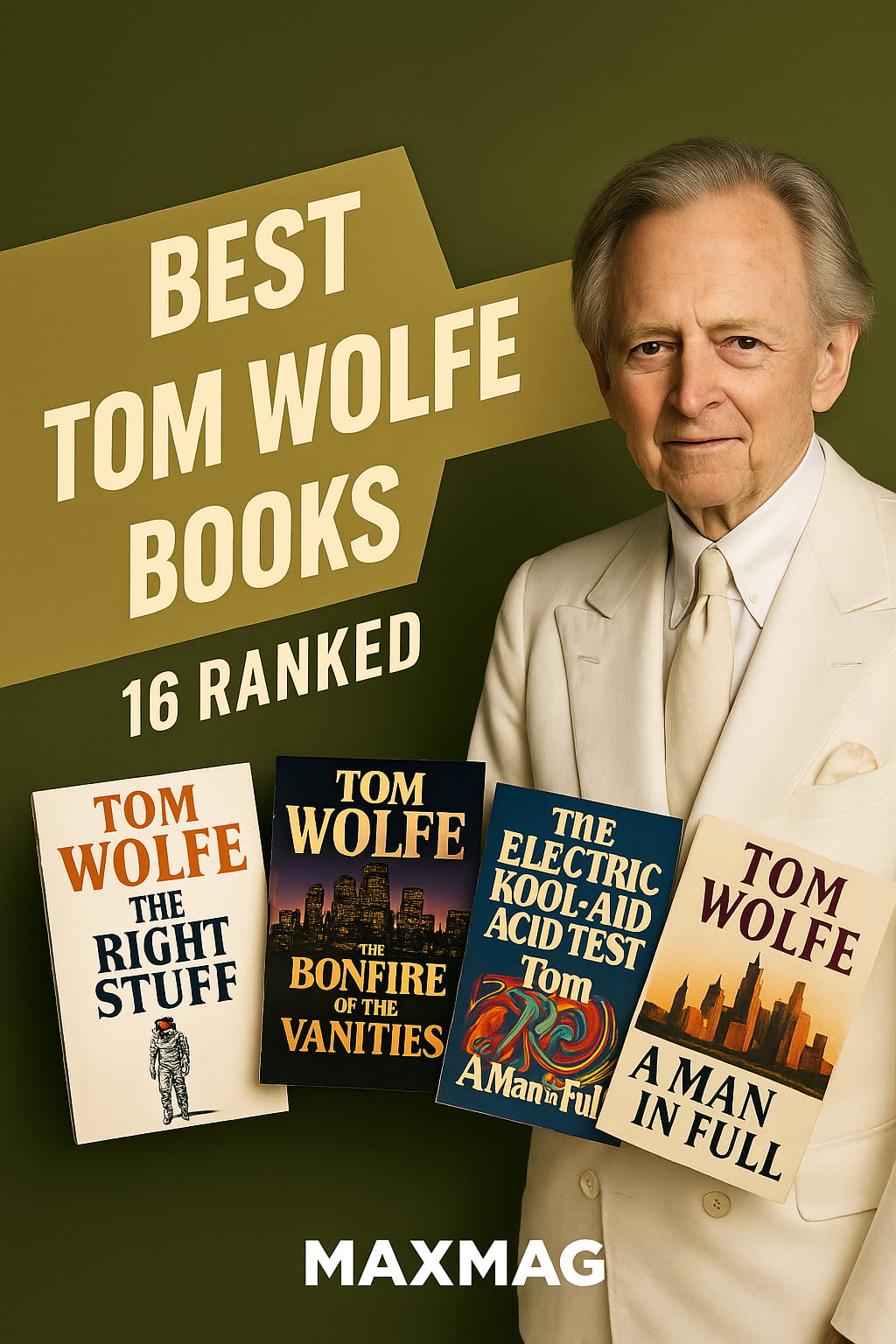
#14) The Bonfire of the Vanities – 1987
- Author: Tom Wolfe
- Published: 1987
- Work Type / Genre Tags: novel, social satire, legal drama
- Themes: class, race, ambition, media
- Goodreads Rating: 3.92/5
New York City sets the scene as bond trader Sherman McCoy, public defender Alberto Cavallo, and reporter Peter Fallow cross paths. A late‑night detour in the Bronx triggers a chain of investigations and headlines. Sherman’s immediate aim becomes self‑preservation as prosecutors circle. Alliances among editors, activists, and officials push the case onto front pages. Mid‑novel hearings, leaks, and grand‑jury maneuvers raise pressure across households. Shifting witness stories and political speeches complicate bargains. The plot drives toward a courtroom arc that tests every character’s calculation. The novel ends with fortunes altered and the city still humming.
#15) The New Journalism – 1973
- Author: Tom Wolfe
- Published: 1973
- Work Type / Genre Tags: anthology, journalism, criticism
- Themes: reportage methods, scene, voice, immersion
- Goodreads Rating: 4.05/5
An opening essay lays out techniques of scene, dialogue, and granular social detail. The volume assembles landmark pieces by writers who pushed those methods into newsprint. The immediate aim is to map how magazines absorbed narrative tools formerly reserved for novels. Editors and reporters appear in origin stories that explain assignments, sources, and risks. Mid‑volume notes connect specific stories to cities, beats, and moments. Debates over objectivity and voice sharpen as examples accumulate. The book heads toward a concluding reflection on where the craft can go next. It closes by fixing a generation’s experiments in one place.
#16) The Right Stuff – 1979
- Author: Tom Wolfe
- Published: 1979
- Work Type / Genre Tags: nonfiction, aerospace history, narrative reportage
- Themes: courage, risk, technology, fame
- Goodreads Rating: 4.23/5
Desert bases and high‑altitude ranges frame the opening as families and crews settle into tense routines. The Mercury program gathers a select group whose flights will unfold in public. The immediate objective is survival and success under new kinds of scrutiny. Friendships, rivalries, and marriages carry the emotional load between missions. Mid‑book training, engineering problems, and launch sequences compress time and nerves. Telecasts and ticker tape widen consequences beyond the capsule and runway. The line rises toward historic attempts that define risk and national pride. The closing pages position the participants as symbols of a new technological era.
Tom Wolfe: Life & Legacy
Born in Richmond in 1930 and educated at Washington & Lee (B.A., 1951) and Yale (Ph.D., 1957), Tom Wolfe built a career that bridged journalism and fiction. He helped define the New Journalism with scene‑rich reportage and cultural inquiry. Signature books include The Kandy‑Kolored Tangerine‑Flake Streamline Baby, The Electric Kool‑Aid Acid Test, The Right Stuff, The Bonfire of the Vanities, A Man in Full, and I Am Charlotte Simmons. His coined ideas such as “radical chic” and the “Me Decade” entered everyday talk and classrooms. Awards and recognition include the National Book Award for The Right Stuff and enduring placement on university syllabi. Influence runs through narrative nonfiction and campus, city, and business novels that adopted similar scene work. That legacy explains why Best Tom Wolfe Books continue to draw students, reporters, and general readers.
Conclusion
Across these 16 entries, the span runs from 1965 magazine‑born essays to late‑career arguments and big‑city novels, showing a path from early subculture portraits to established landmarks. For a high‑quality educational overview, see Washington & Lee University’s remembrance of its alumnus, which sketches dates and contexts (university tribute).
Recurring subjects include status, speech, ambition, institutions, and the theater of American public life; together they map a range from surf breaks to courtrooms, boardrooms, lecture halls, and launchpads, which helps explain why Best Tom Wolfe Books stay relevant in libraries and classrooms. For a trusted U.S. magazine perspective, Smithsonian offers a crisp portrait of Wolfe’s life and impact (background feature), and that same lens clarifies how Best Tom Wolfe Books reflect the last half‑century’s cultural debates.
FAQ: What to know about the Best Tom Wolfe Books
Q1: How did you decide which books qualified for this ranked guide?
Q2: What was Tom Wolfe’s breakout and how does it appear here?
Q3: Do the novels and nonfiction use similar storytelling moves?
Q4: Why do ratings differ across editions?
Q5: Where should a new reader begin?


